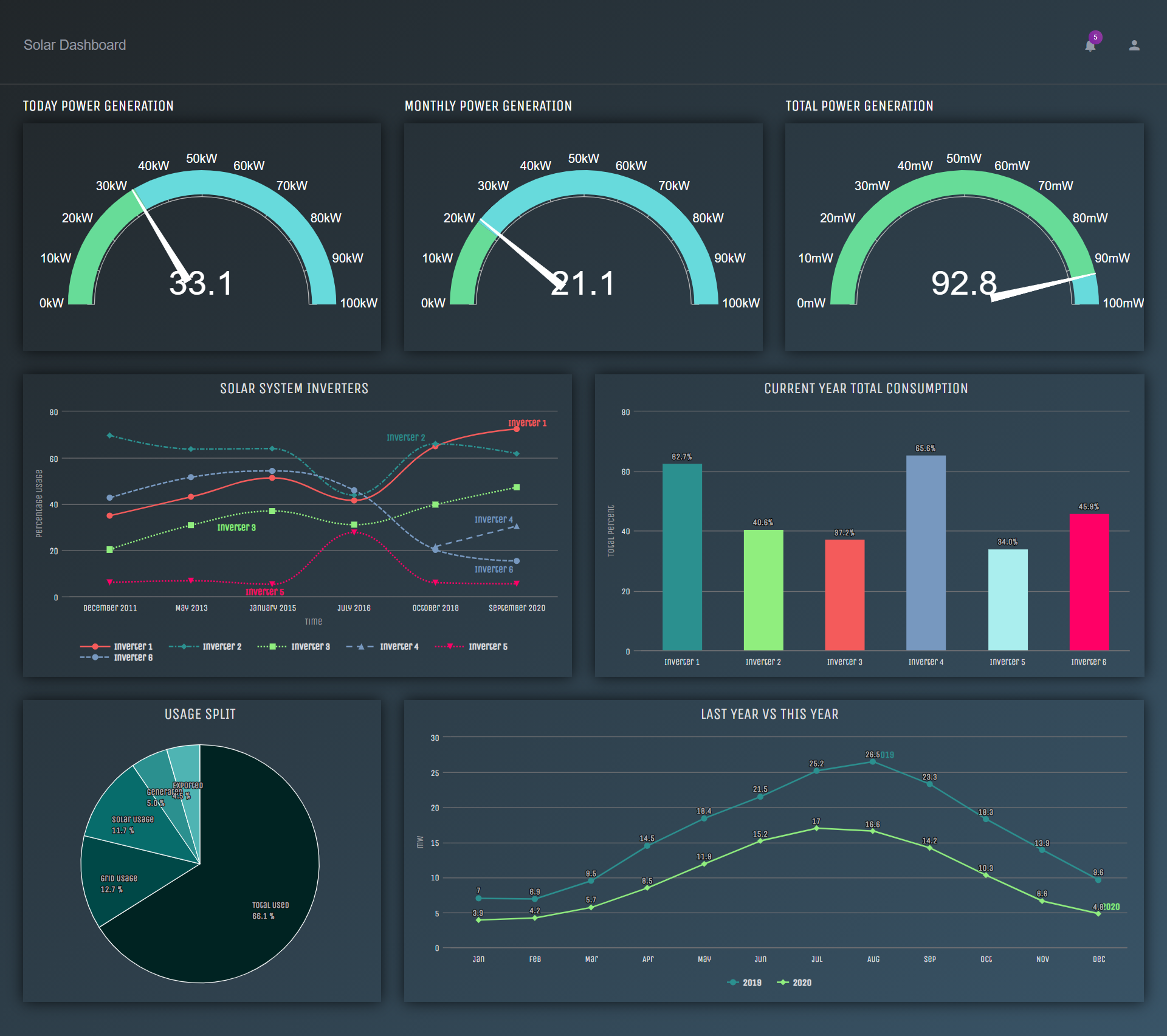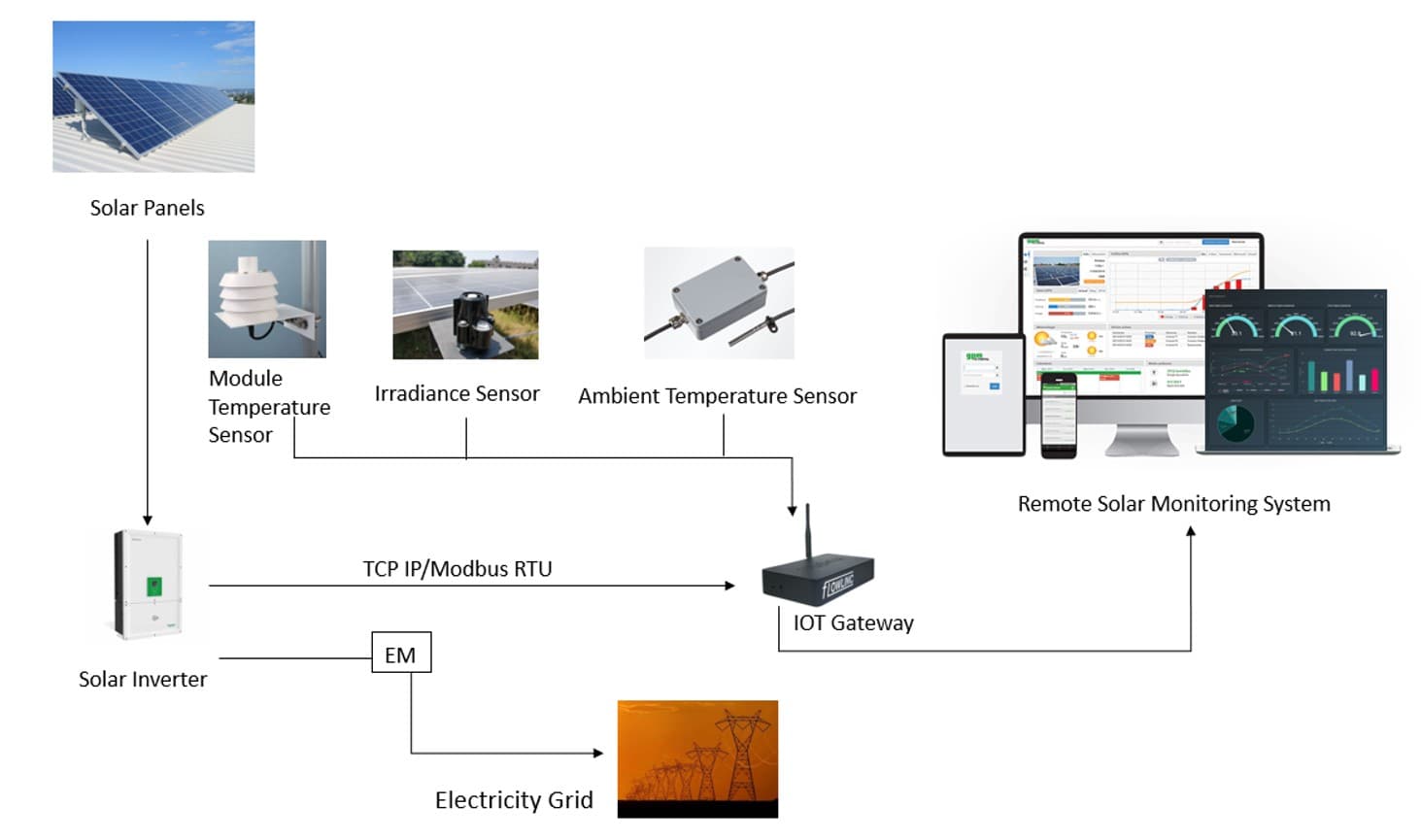Solar Monitoring
For maximum power generation, solar power plants need to be closely watched. This aids in recovering effective power output from power plants while keeping an eye out for defective solar panels, connections, dust buildup reducing output, and other similar problems impacting solar performance.

Customized Dashboard - Features
- Real-time power generation graph
- Total energy generated daily
- Total energy generated by the system since the day of commissioning
- Daily savings because of the use of the system
- Total savings since the day of commissioning
- Grid frequency
- Daily peak power
- Partial Energy
- Voltage, current & power for all the attached solar PV strings
- Real-time weather data
- Device Location

Use Cases
Inverter Monitoring
Remote monitoring of a solar PV inverter is the most crucial aspect . An inverter provides the most crucial information related to the solar PV plant. Information such as voltage, current and power is provided by the solar inverter to the remote monitoring system (RMS) following a communication protocol called Modbus. This data is then pulled by the data logger/ data gateway and uploaded on a web server which can be viewed by the O&M professionals using a highly interactive user interface.
There are various parameters which can be monitored from an inverter using an RMS.
- Voltage, Current, Power and Energy on AC and DC sides
- Frequency, Power Factor
- Inverter Status
- Fault Status
Benefits
Provides users with the ability to view the production of energy through the inverter on a daily, weekly and yearly basis.
Gives you the ability to view the status of your solar inverter. This is a great way to identify signs of problems in your PV system and ensure regular maintenance
It can generate up to date reporting on your inverter’s energy production and detail a breakdown of its performance.
Ability to create alerts that send information to your email regarding any inverter related issues.
Weather Monitoring
Solar PV plant performance and life are critically dependent on surrounding weather conditions. Hence, weather monitoring is a crucial asset to help optimize the overall performance and running efficiency of solar PV systems. Following are some key parameters that directly affect the energy output and hence the ROI:
- Solar Irradiation (Irradiance): A critical measurement allows us to understand how well your system is performing compared to the ideal conditions. This parameter is used to derive the Performance Ratio (PR) of your solar PV plant. This helps in planning maintenance activities like panel cleaning and or other technical faults.
- Module Temperature/Ambient Temperature: Since solar module’s efficiency is dependent on temperature, it gives an indication of the change in the efficiency of modules.
- Wind Speed/ Wind Direction: A critical parameter to consider the plant safety perspective. The heavy winds may cause damage to the solar PV system and hence should be observed regularly for any possible maintenance activities to be carried out.
Benefits
Real-time and historical data enables a comprehensive evaluation of system performance
Compatible with data acquisition devices with simple configuration, hence reducing installation and maintenance costs
Easy visualization of sensor data.
Calculate PR, Expected vs. Actual Power Output, Module Efficiency etc.
Immediate identification of defects and malfunctions in Solar PV systems.
Immediate anomaly detection prevents the solar PV system to remain shut down for a long period due to lack of sufficient information.
Data Storage in case of no internet availability
String Monitoring
String monitoring is a concept where all the strings of solar PV panels [individual solar PV panels in some cases] are monitored to track the output and performance of each unit along with the overall output and performance of the system. The main objective is to monitor the individual string current & common bus voltage on a real-time basis. It also has the temperature measurement facility for keeping a check on the temperature inside the box. The string current, voltage & temperature are measured & communicated through an RS-485 cable over Modbus protocol. Solar Irradiation (Irradiance): A critical measurement allows us to understand how well your system is performing compared to the ideal conditions. This parameter is used to derive the Performance Ratio (PR) of your solar PV plant. This helps in planning maintenance activities like panel cleaning and or other technical faults.
Benefits
Identification of Microcracks: This can happen due to vibrations in the panels or mishandling while installation. These are not visible to the naked eyes but can cause serious loss of energy production over many years.
Identification of PID: Potential Induced Degradation happens in the solar crystalline PV panels caused by stray currents and can cause efficiency loss of up to 30%. This defect can also take up to months to detect.
Identification of cloud or tree shade on panels: This can impact the plant significantly and root cause becomes hard to identify.
